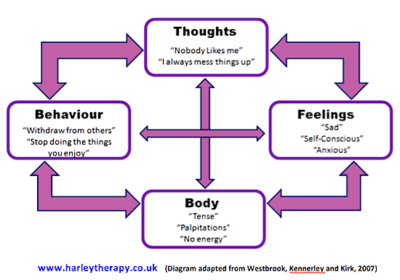What is Cognitive Behavioural Therapy? CBT Explained

By: Cyril Rana
by Andrea M. Darcy
Cognitive behavioural therapy (CBT) is currently one of the most popular forms of talk therapy in the UK, recommended by the NHS for anxiety and depression.
So what is Cognitive behavioural therapy, exactly? And what can you expect from working with a CBT therapist?
What is CBT?
In some ways, it’s in the name. Cognitive refers to how we think. Behaviour refers to how we act.
CBT is a short-term, highly structured form of psychotherapy that helps you recognise and troubleshoot the link between the way you think and the way you end up acting. You learn how your thoughts might be creating a life in which you are unhappy.
Key ideas of cognitive behavioural therapy
A key concept of cognitive behavioural therapy is that it’s often not event themselves that are upsetting you. Rather it is the meaning you attribute to what you experience.
We often get very upset over assumptions we have made that are not even true, but we become so caught up in our emotions and thoughts we don’t realise how far away from facts we have veered.
These thoughts are what CBT calls ‘thinking errors‘, or ‘cognitive distortions’ – thoughts that are distorted from reality. Doing CBT helps you learn the kinds of cognitive distortions you are using without realising it.
The cognitive behavioural approach
 The main idea behind how CBT is that your thoughts, feelings and behaviours form a loop.
The main idea behind how CBT is that your thoughts, feelings and behaviours form a loop.
When your thoughts are negative, you feel negative, and you take negative action, which causes more negative thoughts, and the cycle continues.
This loop becomes a repetitive and increasingly negative cycle until you might feel hopeless and like there is no way out.
An example of this would be if you have a negative thought that “nobody really likes me”. It creates feelings of low self-worth and sadness. So you take the action of not showing up at a party you meant to go to. Which leads to negative thoughts about how you always miss out on good things, and so another loop begins.
Note that you probably didn’t know if all the people at the party liked or disliked you, but you assumed it to be true.
The good news that CBT helps you find a way out of this negative thinking loop. It provides practical ways to stop the loop, either by altering your thoughts or your behaviours.
So what does a CBT session look like?
In your first CBT session or two, your therapist might take you through a questionnaire about your life to learn about who you are and what bothers you. This is when you might find yourself discussing your past, even though CBT is for the most part a present-focused therapy. You’ll discuss what issues you are experiencing, and what goals you have for your therapy.
After that, you’ll generally spend time learning how to identify and challenge your thoughts, feelings, and behaviours, using some of the tools listed in the next session. You will likely sometimes use worksheets.
You will also share the results of the homework you’ve done (unlike other forms of therapy, CBT involves weekly assignments).
How does CBT work differently than other forms of psychotherapy?

By: Joe Bain
CBT is a short-form type of therapy, usually anywhere up to 16 weeks in format. Other therapies like psychodynamic psychotherapy or schema therapy are longer term.
CBT is a present-based therapy. Many other therapies look to your past to understand your present, but CBT tends to just stick to what’s going on for you here and now.
Cognitive behavioural therapy techniques
CBT is a very developed therapy, so there are now many tools your therapist might use with you. But here are a few examples:
Thought records – these are worksheet that help you practise recognising and challenging your negative thoughts before they turn into a negative action (we talk more about thought records in our article on Balanced Thinking).
Behavioural interventions – this is about recognising the activities that improve your mood, then working to have you do that activity more. A simple example would be if going to the gym elevates your mood, but depression means you never get to the gym. Your CBT therapist might help you be accountable to achieving more of this behaviour.
Activity monitoring and scheduling – this helps you get a clear picture of how you actually spend your time. It does things like challenge ideas you have about what you do and don’t actually achieve.
[Read more about CBT techniques in our article on CBT Behavioural Interventions.]
What Issues Can CBT help with?
CBT is evidence-based (proven by studies to help) for the following:
- anger control problems
- anxiety and anxiety disorders
- bulimia and disordered eating
- general stress
- depression.
Would you like to try cognitive behavioural therapy? Harley Therapy connects you with CBT therapists in central London as well as across the UK. Outside the UK?





As a support worker for autism, I’ve witnessed the transformative power of cognitive behavioral therapy. CBT helps individuals recognize and challenge negative thoughts and behaviors, breaking the cycle of negativity. It’s a practical and present-focused therapy that provides valuable tools to improve mental well-being. I’ve seen firsthand how CBT can address issues like anxiety, stress, and depression, offering hope and positive change. It’s an evidence-based approach that brings real results.
Best blog on cognitive behavioural therapy.
You have described much of the ferling I have.
Can you help
You seem to have understanding of up and down emotions rule my world and I need to fix me